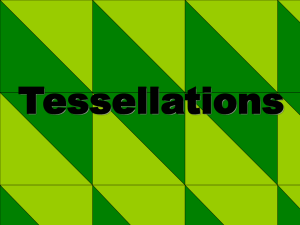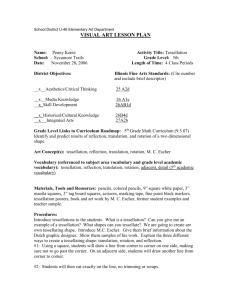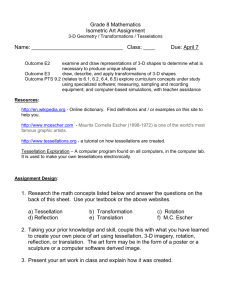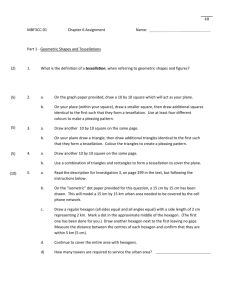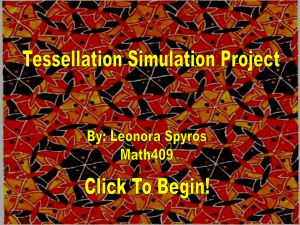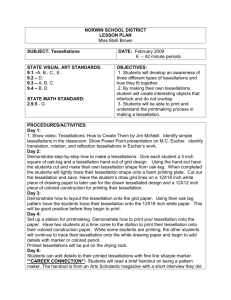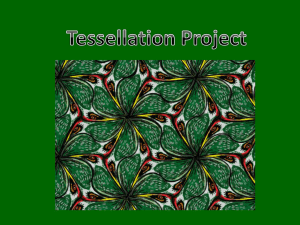PRIMARY STUDENTS’ UNDERSTANDING OF TESSELLATION: AN INITIAL EXPLORATION
advertisement
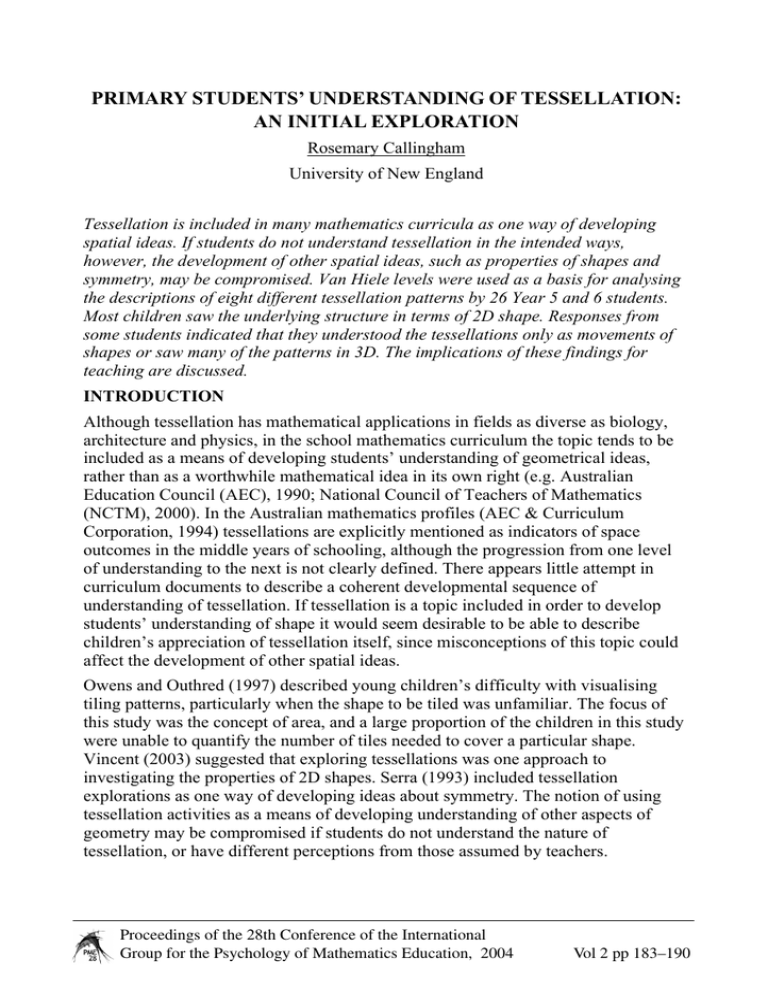
PRIMARY STUDENTS’ UNDERSTANDING OF TESSELLATION: AN INITIAL EXPLORATION Rosemary Callingham University of New England Tessellation is included in many mathematics curricula as one way of developing spatial ideas. If students do not understand tessellation in the intended ways, however, the development of other spatial ideas, such as properties of shapes and symmetry, may be compromised. Van Hiele levels were used as a basis for analysing the descriptions of eight different tessellation patterns by 26 Year 5 and 6 students. Most children saw the underlying structure in terms of 2D shape. Responses from some students indicated that they understood the tessellations only as movements of shapes or saw many of the patterns in 3D. The implications of these findings for teaching are discussed. INTRODUCTION Although tessellation has mathematical applications in fields as diverse as biology, architecture and physics, in the school mathematics curriculum the topic tends to be included as a means of developing students’ understanding of geometrical ideas, rather than as a worthwhile mathematical idea in its own right (e.g. Australian Education Council (AEC), 1990; National Council of Teachers of Mathematics (NCTM), 2000). In the Australian mathematics profiles (AEC & Curriculum Corporation, 1994) tessellations are explicitly mentioned as indicators of space outcomes in the middle years of schooling, although the progression from one level of understanding to the next is not clearly defined. There appears little attempt in curriculum documents to describe a coherent developmental sequence of understanding of tessellation. If tessellation is a topic included in order to develop students’ understanding of shape it would seem desirable to be able to describe children’s appreciation of tessellation itself, since misconceptions of this topic could affect the development of other spatial ideas. Owens and Outhred (1997) described young children’s difficulty with visualising tiling patterns, particularly when the shape to be tiled was unfamiliar. The focus of this study was the concept of area, and a large proportion of the children in this study were unable to quantify the number of tiles needed to cover a particular shape. Vincent (2003) suggested that exploring tessellations was one approach to investigating the properties of 2D shapes. Serra (1993) included tessellation explorations as one way of developing ideas about symmetry. The notion of using tessellation activities as a means of developing understanding of other aspects of geometry may be compromised if students do not understand the nature of tessellation, or have different perceptions from those assumed by teachers. Proceedings of the 28th Conference of the International Group for the Psychology of Mathematics Education, 2004 Vol 2 pp 183–190 One approach to considering students’ understanding of geometric concepts is that provided by the Van Hiele levels (Burger & Shaughnessy, 1986). The five levels, visualisation, analysis, abstraction, deduction and rigour, are hierarchical in nature, and describe increasingly complex reasoning about geometry. The key aspects of each level are: Level 0 (Visualisation): Students take account only of the appearance of the shape, and describe properties only in terms of its appearance. Level 1 (Analysis): Students describe properties informally, and can establish the essential conditions through a consideration of component parts. Level 2 (Abstraction): Students can draw on logic to establish necessary and sufficient conditions when describing the properties of shapes. Level 3 (Deduction): Using formal reasoning systems, students can establish theorems and rely on proof as the ultimate authority. Level 4 (Rigour): Students can move outside a single system and compare and contrast geometries that are based on different premises. The van Hiele levels have been primarily applied to understanding of the properties of 2D figures. Where tessellations were concerned, the understanding demonstrated needed to take account not only of the shapes involved in the tessellation, but also of the transformations applied in order to create the tessellations. At Level 0, students could be expected to identify the shapes involved in the tessellation or the combination of shapes that made up the basic unit that was transformed to create the tiling pattern. Students responding at Level 1 would be expected to describe both the shapes involved and the movements used to transform the shapes but in a disconnected fashion. Those responding at Level 2 could be expected to integrate their descriptions, using some level of technical language such as “flip” or “slide” which is commonly used in primary classrooms. In a very good Level 2 response, there might also be some attempt to quantify the extent of the transformation. Since the students involved in this study were in Years 5 and 6, at the end of primary school, it was not expected that the higher levels of deduction and rigour would be observed. RESEARCH QUESTIONS The research questions for the study were: 1. How do primary school students describe tessellation patterns? 2. Are the van Hiele levels useful in describing students’ understanding of tessellation? METHOD Teachers who participated in a professional development program, Success in Numeracy Education (SINE) that targeted the middle years of schooling (Years 5 to 8), as part of the program were provided with a set of assessment tasks (Callingham, 2–184 PME28 – 2004 Clarke, Falle, Inglis, Lawrie & Pegg, 2003) that addressed different aspects of the Space strand of the mathematics curriculum. All teachers agreed to trial at least one task with their classes, including the tessellation task of interest in this study. The tessellation task was designed to be used by a whole class, but not necessarily under standardised conditions. The task was exploratory in nature, with the aim of providing formative information to teachers so that they could more effectively plan their teaching programs. Eight different tessellations were presented in pictorial form, and students were asked to identify the shapes used and then to describe in as much detail as possible how the shapes were transformed to create the tessellation. The tessellations used are shown in reduced form in Figure 1. In all instances the responses presented were written, although teachers were allowed to scribe for their students where appropriate. The tessellations included regular and semi-regular patterns, one non-periodic tessellation, and patterns that included pentagons. It was anticipated that many of these patterns would be unfamiliar to students, although they were expected to recognise the underlying shapes that made up the unit of tessellation. Using van Hiele levels as a basis, a set of descriptors was developed to provide a basis for the analysis. These are shown in Table 1. No descriptors were provided for the higher van Hiele levels, although it would be possible to describe these, including aspects such as quantification of the transformation. Table 1. Van Hiele levels applied to tessellations. Van Hiele level Descriptor Code Level 0 (Visualisation) Recognises and names the shapes. 1 Level 1 (Analysis) Recognises the shapes and describes the transformation informally. 2 Level 2 (Abstraction) Describes both shapes and transformations unambiguously using technical language. 3 Responses were obtained from 26 Year 5 and 6 students at two Catholic primary schools in Melbourne, Australia. This sample was opportunistic since it depended on the teachers involved in the project. Students coloured in the composite shapes used in each tessellation, and then wrote their descriptions of how the tessellations were made in spaces provided below each design. Students’ responses to each tessellation were coded as shown in Table 1. A code of zero (0) was reserved for an irrelevant or no response. PME28 – 2004 2–185 Examine each of the tessellations below. Identify the shapes used in each tessellation. Explain in as much detail as possible how these shapes have been transformed to make each tessellation. Tessellation 1 Tessellation 2 Tessellation 3 Tessellation 4 Tessellation 5 Tessellation 6 Tessellation 7 Tessellation 8 Figure 1. Tessellation task RESULTS The responses of the 26 students to each tessellation are shown in Table 2 as counts and percentages. The majority of students could describe the tessellations only in a visual manner. This was not unexpected given the age and experience of these primary-aged students. The levels of response shown in Table 2 suggest that as the nature of the shapes of which the tessellation was composed became less familiar the level of response was reduced. Tessellation 1, composed entirely of squares, attracted the highest overall levels of response with nearly half of the students responding beyond the 2–186 PME28 – 2004 Visualisation level. In contrast, no students were able to describe Tessellations 6 and 8 at the Abstraction level. These two tessellations were composed of shapes that might be informally described e.g. “fly wings” and “dumbbells”, and they also had some rotational transformation. Table 2. Responses of students to each question on the tessellation task. Tessellation Irrelevant Visualisation Analysis Abstraction 1 4 (15.4%) 10 (38.5%) 5 (19.2%) 7 (26.9%) 2 2 (7.7%) 14 (53.8%) 7 (26.9%) 3 (11.5%) 3 3 (11.5%) 11 (42.3%) 11 (42.3%) 1 (3.8%) 4 4 (15.4%) 17 (65.4%) 3 (11.5%) 2 (7.7%) 5 6 (23.1%) 9 (34.6%) 9 (34.6%) 2 (7.7%) 6 11 (42.3%) 8 (30.8%) 7 (26.9%) 0 7 7 (26.9%) 13 (50.0%) 5 (19.2%) 1 (3.8%) 8 13 (50.0%) 11 (42.3%) 2 (7.7%) 0 The highest levels of response overall were elicited by Tessellation 1, with over onequarter of the students reaching Abstraction level. An example of the Abstraction level response is: The starting shape is a square, they are all the same size, and they have been slid across and then slid down. (id 25) This response recognises the basic shape, places a condition on this (all the same size) and explicitly describes the movements used in two dimensions to create the tessellation, using the informal technical language (slid) used in the curriculum. Tessellation 3, an irregular tiling pattern produced some somewhat surprising results. The complexity of the pattern seemed to encourage students to apply some level of analysis, although this was not developed further into Abstraction level. A typical response coded at the Analysis level was: I think they started with a square with four triangles on the sides and the[y] overlapped them 12 times to get the shape … (id 11) The idea of “overlapping” was frequently expressed, suggesting that the students were not seeing this as a tiling pattern so much as a design almost in three dimensions. The three dimensional aspects of some of these patterns was notable. Tessellation 7 was seen only as a set of cubes by 13 (50%) of the students. Only one student explicitly connected the two- and three-dimensional aspects of this tessellation: By using the dimond [sic] it looks like block afeact [effect] PME28 – 2004 (id 5] 2–187 This response was coded at the visualisation level. Some students, however, appeared to see three-dimensional shapes in many of the tessellations. One student saw Tessellation 1 as a cube: The starting shape is a cube on side view with another on top (id 19) The way in which this student had coloured the tessellation suggested that this was more than the confusion between the words “square” and “cube”. The response, however, was coded as irrelevant since the student had not identified the shapes involved correctly. For some students, the movements used to create the tessellation, rather than the shapes involved, were dominant. This response to Tessellation 4 describes only the movement rather than the shapes involved, and this student described many of the tessellations in a similar fashion: They have been flipped over and slided. They have drawn triangles and covered all sides. (id 3) This student has not named the shapes involved correctly, but has a relatively sophisticated view of how the tessellation has been created through flipping and sliding. The response however, despite its complexity, was coded as irrelevant since the shapes were not correctly identified. A more typical description of Tessellation 4 was: I see lots of octagons with diamonds between them (id 4) Few students recognised Tessellations 5 and 6 as being composed of pentagons. Some students saw the composite hexagonal arrangement in Tessellation 5, but several students referred to the shape in Tessellation 6 as “fly wings”. It is likely that students have had little exposure to a wide range of two-dimensional shapes, other than the regular shapes found in commercial pattern block sets, and thus could not easily identify pentagons. DISCUSSION A majority of students in this study described tessellations in terms of the shapes of which they were composed: Visualisation level. This did appear to depend, however, on the nature of the shape. Familiar shapes, such as squares and triangles, were more likely to be named whereas only 50 percent of the students could describe Tessellation 8 coherently in terms of the shapes that comprised the design. Familiar shapes also appeared to support higher level descriptions. In terms of tessellation, however, the familiarity could also be something of a hindrance. Tessellation 4, for example, was described by nearly two-thirds of the respondents in terms of octagons and squares, with no suggestion of transformation. Few students were able to reach Abstraction level on any tessellation and this result is not surprising given their age and experience. Most of these students were, however, in a position to develop understanding of the properties of shapes with appropriate 2–188 PME28 – 2004 teaching intervention since they were able to recognise and name the shapes in most instances, and this provides a starting point for further work on properties. The complex design of Tessellation 3 appeared to support students to reach Analysis level. Similar comments could be made about Tessellation 2 and Tessellation 6. In order to encourage understanding of tessellation, it would appear that students should experience a wide range of designs, made up of familiar and less familiar shapes and transformations. Of particular interest, however, were the unusual and unexpected responses. It was surprising that a number of students saw many of these designs in three dimensions. This finding suggests that even in the later years of primary school there are a number of students having difficulty understanding 2D representational conventions. The misconceptions shown by some students could compromise their understanding of the properties of 2D shapes, and subsequent development of geometrical ideas. Those students who saw only the movement of the shapes, rather than the shapes themselves, were in a position to develop understandings of symmetry beyond that of simple reflection symmetry. They could, however, have difficulty developing understanding of the properties of shapes. In contrast, those students who recognised shapes but made no mention of their transformation could have difficulty developing understanding of symmetry, particularly rotational symmetry which inherently demands some identification of movement. Using the van Hiele levels as a basis appeared to provide a useful means of identifying primary students’ understanding of tessellation, that included both recognition of the shapes involved and the transformations used to make the design. It did not, however, adequately identify the nature of the misconceptions shown by some students. This is one limitation of using van Hiele levels, since the types of misconceptions shown potentially could affect students’ development of geometrical understanding. CONCLUSION It appeared that the majority of students in this small exploratory study could recognise and describe a range of regular shapes when these were part of a tiling pattern. Their recognition of geometrical transformations, however, was more limited, particularly when the shapes involved were less familiar. There were also some unexpected and unusual responses, which might have an impact on students’ future understanding. This has implications for the use of tessellation as a means of developing geometrical insight. Teachers should not assume that all students visualise tiling patterns in the same way. Although a majority of students responded in expected ways, some appeared to view tessellation only in terms of movement, and others saw the tilings in three- rather than two-dimensions. These unusual responses have implications for teaching. If tessellation is used as a means of developing students’ geometrical knowledge of the properties of shapes, and of symmetry and transformation, then opportunities are PME28 – 2004 2–189 needed for all students to learn about both aspects of tessellation: the nature of the shapes involved and also the kind of transformation applied. The mathematics of tessellation is not generally well developed in the school curriculum. This initial study suggests that young students do not necessarily respond to tiling patterns in expected ways. Further research into older students’ comprehension would be useful to explicate a developmental sequence of understanding of tessellation. In addition, further research into students’ apparent misconceptions would provide useful information relating to the development of ideas about symmetry and transformation. References AEC & Curriculum Corporation. (1994) Mathematics – a curriculum profile for Australian schools. Melbourne, VIC: Curriculum Corporation. Australian Education Council (AEC) (1990). A national statement on mathematics for Australian schools. Melbourne, VIC: Curriculum Corporation. Burger, W.F. & Shaughnessy, J. M. (1986). Characterizing the Van Hiele levels of development in geometry. Journal for Research in Mathematics Education, 17, 1, 3148. Callingham, R., Clarke, G., Falle, J., Inglis, M., Lawrie, C. & Pegg, J. (2003). Space strand assessment tasks, Levels 3, 4 and 5. Melbourne, VIC: Catholic Education Office. National Council of Teachers of Mathematics (NCTM). (2000). Principles and standards for school mathematics. Reston, VA: Author. Serra, M. (1993) Discovering geometry. An inductive approach. Berkeley, CA: Key Curriculum Press. Vincent, J. (2003) Federation Square and Storey Hall: Pinwheels, kites and darts. In B. Clarke, A. Bishop. R. Cameron, H. Forgasz & Wee Tiong Seah. Making mathematicians. Proceedings of 40th Annual Conference of the Mathematical Association of Victoria (pp. 232-241). Melbourne, VIC: MAV. 2–190 PME28 – 2004
